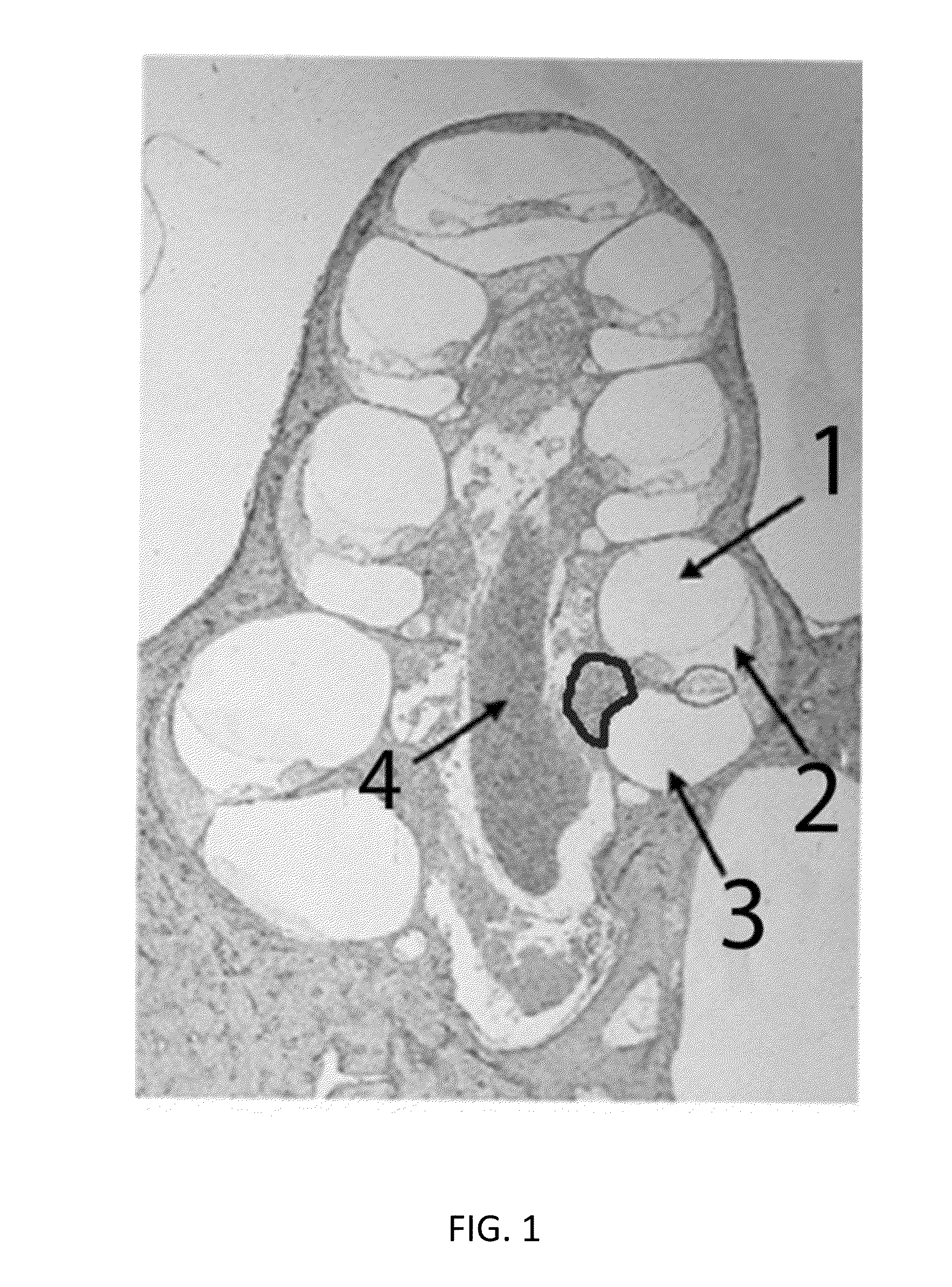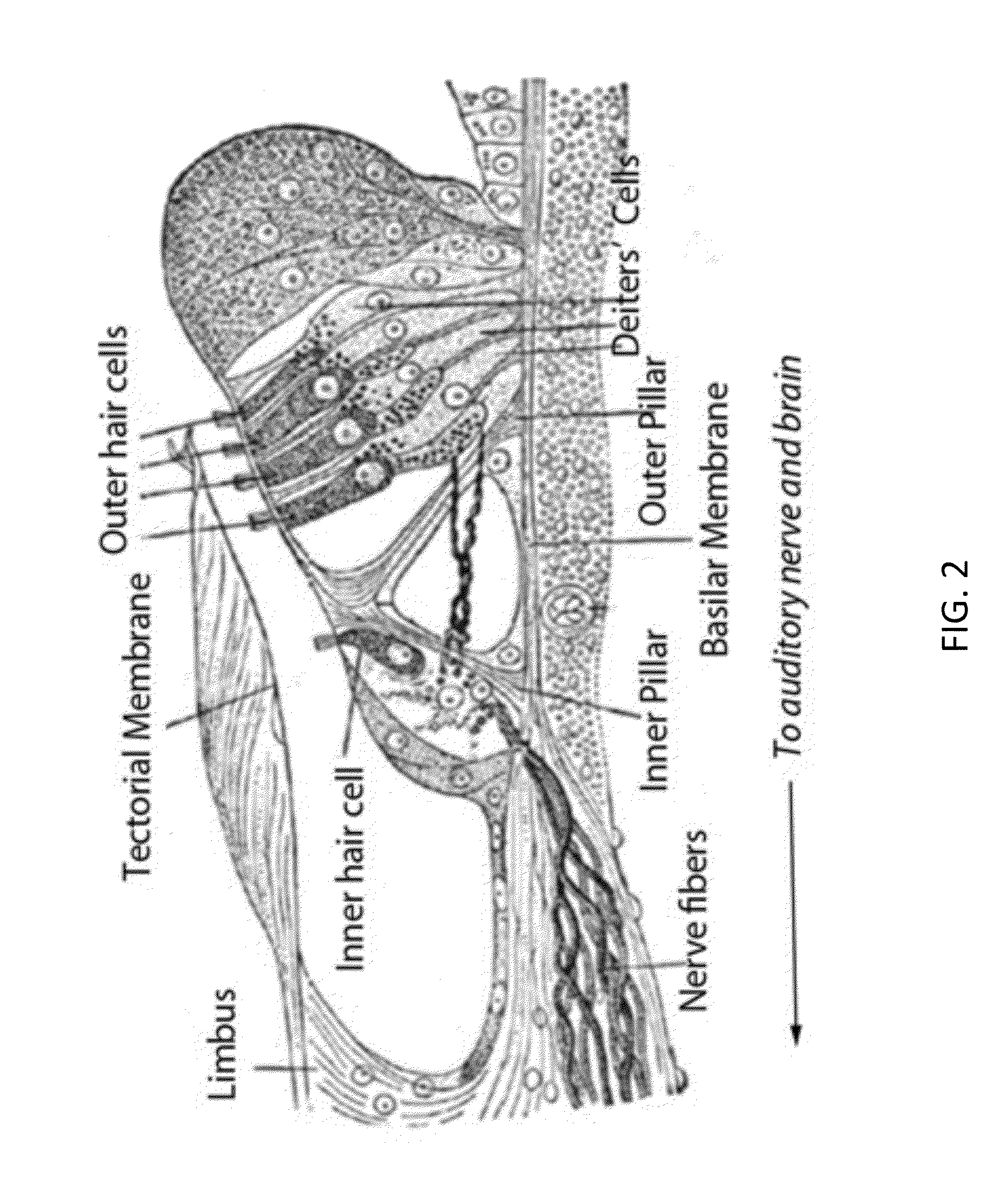Local cochlear application of statins for stimulating neurite regrowth in the cochlea
a cochlea and cochlea technology, applied in the field of local cochlear application of statins, can solve the problems of “temporary” deafness, failure to reveal serious aspects of hearing damage, and damage to neurons that are required to encode acoustic information at higher sound levels, so as to prevent or treat hearing loss
- Summary
- Abstract
- Description
- Claims
- Application Information
AI Technical Summary
Benefits of technology
Problems solved by technology
Method used
Image
Examples
example 1
Materials
[0117]Animals—
[0118]CD-1 mice (Charles River Laboratories, Wilmington Mass. [US]), age newborn, were used for cultures that test neurite length; postnatal day 1-2 mice were used for cultures that test survival. Mice were anesthetized by cooling at −80° C. for 4 minutes and euthanized by aseptic decapitation.
[0119]Reagents—
[0120]Pitavastatin Calcium was obtained from Selleck Chemicals (Houston Tex. [US]) and was prepared initially as a 10 mM stock solution in DMSO. Pitavastatin dilutions were made in DMSO. H1152, fasudil, hydroxyfasudil were obtained from EMD Millipore (Billerica, Mass. [US]); laminin, Penicillin / Streptomycin stock (10,000 units Penicillin and 10 mg Streptomycin per ml), DMEM / Hams F12 (1:1) medium, 45% glucose, DNAse I (10 μg / ml), Dulbecco's phosphate buffered saline without calcium or magnesium (DPBS), glucose (45%), DNAse, L-glutamine, Leukemia Inhibitory Factor (LIF) and DMSO were purchased from Sigma-Aldrich (St. Louis, Mo. [US]). Brain derived neurotrop...
example 2
In Vitro Screening Assay Procedures with Pitavastatin
[0123]Cultures—
[0124]Cultures were prepared by a modification of the procedure previously reported and modified (Whitlon et al., Neuroscience 138, 653-662 (2006); Lie et al., Neuroscience 169, 855-862 (2010); Whitlon et al. Neuroscience 146, 833-840 (2007); Whitlon et al., Neuroscience 161, 227-235 (2009)). To increase the number of cultures produced from one dissecting session while maintaining consistency in the preparations, the number of animals was increased to 8 (16 cochleas, a practical limit) and the volume of the cultures was decreased to 50 μl. Cells derived from the equivalent of 0.073 ganglia were plated in each well. These changes allowed the material from each dissection session to be cultured in 192 wells of a standard 384 well plate. Each dissection session could accommodate 3 controls and 45 compounds in quadruplicate. The cochlear capsule was opened and the tissue was treated with Dispase, 5 units / ml. After washi...
example 3
Animal Model Screening Procedures
[0131]Drug efficiency was tested in guinea pigs, 200-500 g in body weight. The approach was as follows. Baseline cochlear function was determined with auditory brainstem responses. Sound levels to evoke a visual ABR response were determined for pure tones at selected frequencies between 2 and 32 kHz and for acoustic clicks. Delay times and amplitudes for wave I-V of the ABR were measured. A small ˜180 μm catheter was surgically implanted into scala media of the cochlear basal turn. Through this catheter the drug dissolved in a carrier was delivered with an osmotic pump. After the pump implantation, the animals were allowed to recover from anesthesia. The animals were exposed to broadband noise (4-8 kHz or 8-16 kHz at 100-120 dB for 1-4 h). Noise exposure was always after baseline cochlear function was established and 1 week before pump implantation to determine the ability of the drug to repair and reverse degeneration, and during recovery from impla...
PUM
| Property | Measurement | Unit |
|---|---|---|
| neurite lengths | aaaaa | aaaaa |
| neurite lengths | aaaaa | aaaaa |
| neurite length | aaaaa | aaaaa |
Abstract
Description
Claims
Application Information
 Login to View More
Login to View More - R&D
- Intellectual Property
- Life Sciences
- Materials
- Tech Scout
- Unparalleled Data Quality
- Higher Quality Content
- 60% Fewer Hallucinations
Browse by: Latest US Patents, China's latest patents, Technical Efficacy Thesaurus, Application Domain, Technology Topic, Popular Technical Reports.
© 2025 PatSnap. All rights reserved.Legal|Privacy policy|Modern Slavery Act Transparency Statement|Sitemap|About US| Contact US: help@patsnap.com



